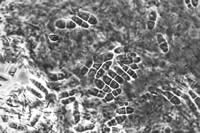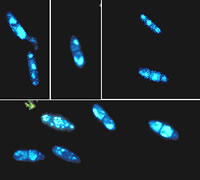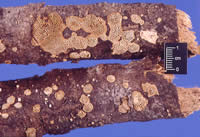Revision of polypore fungi
Taxonomy and distribution
The most recent monograph of polypore fungi of New Zealand and Australia (Cunningham 1965) described 242 species. Since 1965 taxonomic concepts in these fungi have altered, especially at the generic level, with incorporation of new characters such as brown versus white rot. Large heterogeneous genera have been divided up into more narrowly defined genera. As a result of generic revision and species redetermination only 39 (16%) of the species names used by Cunningham are accepted today.
Taxonomic revision of polypore fungi is in progress for publication in a new series, Fungi of New Zealand. The work is based mainly on Cunningham's collections along with our more recent collections deposited in the New Zealand Fungal Herbarium (PDD). Currently recognised are 163 species, arranged in 60 genera (Table 1), half of which contain only a single New Zealand species. One genus, Australoporus, is considered to be endemic to the region. Seventeen percent of New Zealand species are endemic and a further 19% are known only from New Zealand and Australia; the balance are wider ranging. Brown rot species comprise 18% of the total New Zealand species (Table 2), a proportion comparable with that in northern temperate regions.
Table 1
| Taxonomy - 1965 cf. 1997 | Cunningham(1965) | Currently | |||
| No. of genera represented in New Zealand | 26 | 60 | |||
| No. of genera containing single New Zealand species | 6 | 30 | |||
| No. of New Zealand species | 141 | 163 | |||
Table 2
| Polypore fungi | New Zealand | Japan | North America | Europe | East Africa |
| Total species (n) | 163 | 246 | 370 | 322 | 322 |
| Brown rot species (%) | 18 | 13 | 19 | 24 | 5 |
Septate basidiospores - first report for polypore fungi
Polypore (and agaric) fungi, until now, have been characterised by unicellular basidiospores. Among a number of PDD collections bearing misapplied Northern Hemisphere names, we have discovered two new species with a novel feature - occasional uniseptate to multiseptate basidiospores.
Polyporus septosporus sp. nov. established for PDD collections misidentified as Polyporus udus, has abundant 1 to 3-septate basidiospores in a spore deposit on the pileus surface of the holotype (Fig. 4). Spores measure 11-18.5 x 4-6.5 µm. Occasional septate spores were observed in two other collections. Septate spores appear to have nuclear material in each cell. (Fig. 2). Almost all basidiospores in tubes are nonseptate (Fig. 4a), although a few 1 or 2-septate spores were seen. This species is also recorded from Australia, and may be the same as Polyporus tasmanicus Massee 1899, non Berk. 1860, known from Tasmania. Basidiocarps of P. septosporus (Fig. 3) are lignicolous, funnel-shaped, and display a conspicuous red coloration of the pileus and pore surface in response to 3% KOH.
In the type specimen of Dichomitus newhookii sp. nov. (ined.) (PDD collections misidentified as Poria leucoplaca) about 10% of basidiospores are 1 to 4-septate (Fig. 6). Spores measure 12.5-23.5 x 5.5-9 µm. Some septate spores from the type specimen were observed in the process of germination, suggesting - as with Polyporus septosporus - that septation may develop only in older spores, following detachment from the sterigma. Septate spores were not seen in a second specimen examined. Basidiocarps of D. newhookii are resupinate, cushion-shaped, and have large pores (Fig. 5). D. newhookii is currently known only from New Zealand.






